MSA-eXperimental VSPACE
“At Times We must CREAT our Reality than live in the present illusion”
MSA-X celebrates 35 years of founded with the opening of the exhibition “The Man That Could Fly” artworks by Jorge Bartlett, 1957-2008, best known as KMAN. Kman was one of MSA’s most important collaborators since its inauguration in 1985 in San Juan, Puerto Rico.
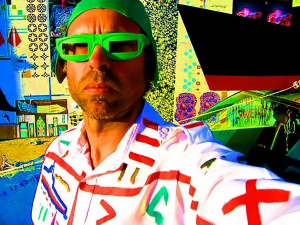
One of the first interventions of KMAN, was in 1983 during a John Cage conference at Florida International University in Miami, wearing a mosquito net, camouflage vest and face paint. During the whole conference the perplexed public tried ussesly to ignore the uninvited visitor withouth success!.
KMAN was a transgressor, visionary, who unapologetically intervened in public spaces as well as galleries and museums, openly exposing the superficiality of the art world, its institutions and collectors. His art was deeply rooted in inequity and the impact of politics, military presence, war, and exile as human experiences.
KMAN was also known for his famous speeches at Wynwood during art events. It was then when he created: Kendallman Art Gallery Ambulante (Kaga). Kaga was according to KMAN “the smallest art gallery in the world” and it contained all of the artist’s creation that in those years had been strategically reduced in size until it became portable.
Among his most remembered exhibitions are the Artman Solo Show at Edge Zone Contemporary Art Gallery where he presented paintings, drawings and performances that intertwine speed and transmutation, as well as his participation in Context 3, at Leonard Tachmes Gallery where he exhibited more than twenty years of drawings on the life of the city.
In 2008 El Museo del Barrio in New York invited KMAN to participate in the iconic exhibition “Arte no es Vida”.
KMAN was also invited to several international art events, CIRCA Art Fair in Puerto Rico, 2006, the International Festival of Performance INDEX in Dominican Republic, 2007.
KMAN: The Man who Wanted to Fly
by Janet Batet, El Nuevo Heral May 17, 2020
English version: Repeating Islands
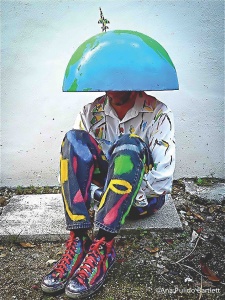
We are deeply grateful to art writer and curator Janet Batet for providing a translation of her recent article (El Nuevo Herald, May 17, 2020) “KMAN: El hombre que quería volar,” on Cuban-born artist Jorge L. Bartlett, better-known as Art Kendallman, or KMAN (1957-2008). [Read the original, with video and photo gallery at El Nuevo Herald.] Batet writes:
To say that Jorge L. Bartlett wanted to fly for the mere fact that he had an obsession with planes would be just obtuse. We should start by saying that Jorge L. Bartlett (Villa Clara, 1957 – Miami, 2008) was a man of conviction that knew no fear when something got stuck in between his eyebrows.
Jorge L. Bartlett is one of those unavoidable figures in the Miami art scene fallen into oblivion because of that this city’s mania to always start from zero. But for those interested in South Florida history and its art in its most unprejudiced, committed, and alternative version, Jorge L. Bartlett is a must.
Better known as Art Kendallman or KMAN, Bartlett’s controversial alter ego stormed Miami in the early 1980s. It was common then to see him dressed in his military paraphernalia: hand-painted jumpers with strident colors that covered him from head to toe; sneakers adorned with colorful soldiers, helmets with planes, rockets, radars; use of camouflage, reconnaissance missions, miniature military vehicles; alternative electronic music accompanying their performances and that bombardment of flyers that were the genuine call that only a few understood.
The influences that converge on the misunderstood and relevant KMAN avatar are diverse. As far as art is concerned, Joseph Beuys’ extended notion of art with its participatory and transformative potential, as well as Chris Burden’s idea of personal danger as the ultimate artistic expression, clearly define Bartlett’s stance on art; while Guerrilla Art Action Group (GAAG), with its radical public actions as a political protest independent of the rarefied artistic system, soon defined the KMAN strategy of action; to which should be added the adoption of the multidisciplinary and experimental character of Fluxus.
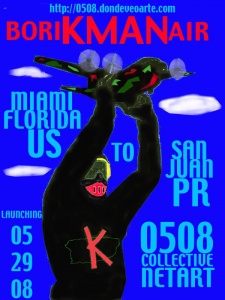
Beyond the art grounds, Hopi’s spirituality and their Kachinas – those ancestral spirits carrying salvation, capable of moving at supersonic speeds in futuristic flying artifacts – are very present in KMAN. His avatar is a sort of reminiscence of Hopi figurines, the incarnation of those spirits, always dressed in helmets and strange garments of energetic symbolic connotation.
Having embraced the strategy of military intervention as the only plausible way to shake up the status quo, KMAN arrived without asking for permission. Among his typical interventions are his numerous Aircraft Bombing Art Maneuvers (maneuvers of art bombardment from aircraft) that became common in the eighties. KMAN also invaded by land, with his ships and his person. And he did it in museums, galleries, or in the street.
One of his earliest interventions was in 1983, during a John Cage conference at FIU. Wearing a mosquito net, camouflage vest, and face paint, the puzzled public tried to ignore the importunate visitor. A year later, he performed Cars Kill, wearing a pink tutu down Kendall Drive as he challenged the drivers with his compelling message. Most of his actions included his family and closest friends. Among his most iconic interventions highlight Más-caras Manifestación Sintetista Actualizada (San Juan, Puerto Rico, 1985); Monkey Ass Fault Jungle (Miami Wave Art Festival, 1986); Japan Art Invasion. Kman III and Blast Off! (1990 and 1991 respectively, both at the Cameo Theater and as part of Mia Art Assylum); KMAN Supersonic Fly from Kendall Tamiami Airport to Helix Art (2005, Helix Art Gallery), as well as his interventions in Mango Strut parade, Art Miami and Art Scope, among others.
Among his most memorable exhibitions are Artman solo show at Edge Zone Contemporary Art Gallery where he presented paintings, drawings and performances that intertwined speed and transmutation, as well as his participation in Context 3, at Leonard Tachmes Gallery, where he exhibited more than twenty years of drawings on city life. Both exhibitions from 2007.

Kman was also invited to the INDEX International Performance Festival, Dominican Republic, 2007, and was included in the iconic Arte No es Vida (Art Is Not Life) exhibition at El Museo del Barrio in 2008.
His public interventions were common in the Wynwood Arts District. There, another of his main artistic pleas was born: Kendallman Art Gallery Ambulante (Kaga), which had a lot of Fluxus and Marcel Duchamp’s Boîte-en-valise. Kaga was, according to KMAN himself, “the smallest art gallery in the world” and it contained all the artist’s creation that by then had strategically reduced its dimensions to become portable.
Deeply mythical and environmentalist, KMAN’s work, sometimes resulted in ritualistic destructions: the mirror of that constant inner struggle that was the harsh dialogue of KMAN and the artistic circuit. One of these battles took his life. So I imagine him, in his perennial flight, aboard one of those supersonic ships, now turned into KMAN-Kachina, guiding and protecting our existence forever.
Janet Batet (janetbatet@gmail.com)
[Photo above by Ana Pulido Bartlett: KMAN wearing a cap in a photo taken for Urban Decay Magazine and later used in a fashion magazine, Summer 2002, Issue 2. Courtesy/ Ana Bartlett. Accessed via El Nuevo Herald.]
Read the original article (in Spanish, published at El Nuevo Herald) and see video and photo gallery at https://www.elnuevoherald.com/vivir-mejor/artes-letras/article242644936.html
[/su_tab]
[su_tab title=”Underground Artists Use Exploratory Mediums” disabled=”no” anchor=”” url=”” target=”blank” class=””]
UNDERGROUND ARTISTS USE EXPLORATORY MEDIUMS
By MARY STAPP, Special to the News/Sun-SentinelSUN-SENTINEL, october 2, 1987
And now for something COMPLETELY different …
What do buzzards, solar electronic sounds and the papal parade all have in common?
Nothing. Unless you’re interested in art of an underground nature — art that is, quite literally, off the wall. Outside of the museum and gallery boundaries in Dade County there are a number of artists who work not for your entertainment, or for the decoration of your bare walls, but for exploratory purposes.
Take South Miami Beach artist Russel Frehling, for example. Frehling, 35, does sound installations — works of art that define spaces aurally rather than visually. He describes the art as more architectural than anything else because it explores the solids and voids of a room, or a park, as in the piece commissioned by Art in Public Places last spring.
Frehling starts with the available sounds in a given environment and uses electronics to manipulate them. “I work with these resident sounds in the same way a painter works with a palette,” Frehling said.
The “concerts” sound more like noise than music, but the point is to create an awareness, not to entertain. The point is “to erase the hierarchy of sounds,” the artist said. “There is no arrangement, no editing or choices. It creates a piece of art that gives the listener a sense of participation and a perception of something new.”
Some of the concerts are barely audible, such as the one at Crandon Gardens for Art in Public Places in Key Biscayne. Frehling said he has a neighbor who was in the park shortly after the piece was installed. There were no signs announcing the artwork, and the neighbor didn’t know about Frehling’s work at the time.
Frehling said, “He told me, ‘I was hearing this thing, but couldn’t figure out what it was. It sounded like a faint machine, and then I thought maybe it was crickets.’ You see, he heard it changing as he walked through it, and it made him wonder.”
That piece was done by solar-generated electricity, and Frehling used it as an alarm clock before it was installed at the park. As soon as the sun rose and light filled his room, the low drone would start.
“What I really liked about that piece was that it worked really well in that environment,” the artist said. “It refracted around trees and bushes and you — as you moved through it.”
The new art mediums are no longer as simple as paint and clay; they are sounds such as those Frehling creates, or at another extreme the artist is himself the art object.
At least one of the artists in “A Tribute to Andy Warhol,” a recent opening at Miami’s Joy Moos Gallery, demonstrated the latter.
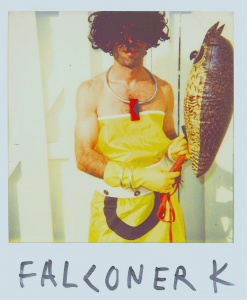
Art Kendallman sauntered into the gallery wearing his lime-green felt blouse and obnoxiously printed, ankle-length skirt. Peering out from behind goggles made from screens, he told a reporter that he wasn’t Art Kendallman. He was Art’s girlfriend. Naturally.
“Art is in jail,” he said in a shrill voice, twirling his cowrie shell necklace. The little body was almost convincing. “The police beat him up, and he’s in jail now.” Then he fished around in his old, bone-colored purse, dangling from a tarnished gold chain, and handed out prints of a drawing on paper detailing his arrest at the papal parade.
It was the censorship that bothered him, he says, and that continues to be the topic of his work.
Later he said, “I saw a lot of people at that art show who seem to think life is just an art opening. My point is that there is all this aggression and abuse and things we’d really just like to turn our heads from — but shouldn’t.
“The abuse that goes on is something we’ll all pay for. Most crime is a result of the anger that grows inside a person who has experienced this abuse. Why do you think they had riots in Overtown? They didn’t break out in Kendall did they? Why do you think all those kids are throwing rocks at cars on the turnpike? That’s a lot of anger, man.”
While both Frehling’s and Kendallman’s performances are solo and outside of any art group, there are a number of organizations in Miami that have formed out of a need for the solace (and jobs) that result from an association with a community.
Artifacts is one group of relatively young artists that made its name doing weekly installations in downtown’s progressive music club, Fire and Ice. They have since founded their own “space” (gallery is a dirty word that connotes commerce) on Michigan Avenue in South Miami Beach.
The space may be right around the corner from the South Florida Art Center, but Artifacts doesn’t want to be associated with any societies. Even so, Artifacts leader Howard Davis would like to see a multiarts facility in Miami that would be similar to the Institute of Contemporary Art in New York.
“It would have a specific mandate to explore and promote new art,” Davis said, and would include a theater, cinema, video, exhibition space, a bookstore, cafe and bar.
“Miami being as segregated and segmented as it is, this facility would ideally be located in the downtown area, because we need some centrality,” Davis said.
Ironically enough, this is what two new centers are trying to do — provide some centrality for artists. The downtown Bakehouse Art Complex is an old bakery that has been converted into studio space for artists. The facility is run similar to a cooperative so that they can provide low rents to artists who need working space.
Henry Zaragozi, 27, was there on a recent weekday and said that he has recently begun full-time work as an artist. Having a studio helped to persuade him to “give up the nine-to-five treadmill,” and quit his job as a mortgage loan representative for Dade Savings Bank.
Despite the praise of resident artists, Davis said, “The Bakehouse and South Florida Art Center (on Lincoln Road) were established for economical reasons and tend to perpetuate the status quo.”
Frehling, unaware of Davis’ comment, agreed. “In general there are good artists down here, but they’re not the ones pushing these art communities like the one downtown and here on Miami Beach at Lincoln Road Mall,” he said. “This area just doesn’t seem to lend itself to that.”
Marilyn Gottlieb-Roberts, 48, believes that is changing. She was hired early this year by Miami-Dade Community College to bring her expertise in new age art to the college’s new satellite campus on South Beach. That school is an alliance between South Florida Art Center and M-DCC. (Incidentally, Davis teaches a class there called “Fish and Roses,” which is all about the contemporary art scene in Miami and beyond.)
Roberts also is responsible for initiating and directing the Miami Waves Festival, an avant-garde festival of films, video and performance that began three years ago.
The festival has used the migratory vulture as its central metaphor. Vulture Kulture is the festival’s culmination, and this year Roberts said it will be a natural migration beginning at sunrise with a performance at the Atlantic Ocean and will progress — with various performances throughout the day — across Lincoln Road. The parade is to end at sunset on Biscayne Bay.
The festival will take place on Jan. 15, 16 and 17.
[/su_tab]
[su_tab title=”When Art Attacks” disabled=”no” anchor=”” url=”” target=”blank” class=””]
When Art Attacks
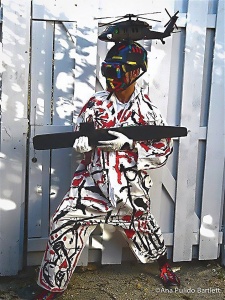
According to Miami native Art Kendallman (not his real name), art is war. The performance artist is a one-man fighting force railing against the big business art concept the only way he knows — through a visual assault on unsuspecting passersby. While Art Basel invites patrons to immerse themselves in a world of galleries and museums, the Kman aims to remind would-be collectors that while the art hangs inside these galleries, the artists die hungry on the streets.
“I’m not going to be marginalized by anyone. The Art Basel people come in and they take over the place. I’m saying, ‘Hey, this is my native land.’ A lot of my worst experiences have been with what I like to call the Art Dick-rectors. They sell out, and then they’ll crush you if you get in their way,” said Kendallman.
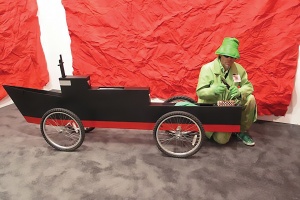
Kendallman’s work consists of scale models of helicopters, planes, rocket ships or anything having to do with the notion of travel and movement. The thing to remember is that he is the art. So, instead of just producing it, he lives it. It would not be uncommon to spot this kooky man dressed as a space alien in green tights or cruising down South Beach on a bicycle fitted to look like an F-16 fighter jet. During Art Basel, patrons can spot the Kman on Thursday, 9:00 a.m. to noon, as he makes the rounds to all the galleries in the Design District. Friday, he will be strolling through Collins Park between 7:00 and 9:00 p.m. Saturday, look toward the water: Kendallman retrofits a canoe to look like a war boat strapped with missiles. He plans to make his way from Biscayne Bay to the Miami Beach Convention Center.
[/su_tab]
[su_tab title=”Art as Life and Death: KMAN is Gone and Remembered” disabled=”no” anchor=”” url=”” target=”blank” class=””]
Art as Life and Death: KMAN Is Gone and Remembered August 2008 Biscayne Times

On June 28, the body of Jorge Bartlett was found in Kendall Indian Hammocks Park. The performance artist, more commonly known as Art Kendallman, or just KMAN, had been missing for eight days. Police determined that he had taken his own life.
“I’m still puzzled because a lot of really good things were happening for him,” says artist and longtime friend Teofilo Freytes. “He inspired me. He lived his life as art. I really miss him so much.”
The 51-year-old Bartlett spent his life making drawings, paintings, and sculptures, but he was perhaps best known for his unique form of performance art. He would commonly appear in public dressed in helmets and crazily painted jumpsuits, carrying miniature models of airplanes or military vehicles, often accompanied by a portable soundtrack of experimental music. In his role as KMAN, he elicited a range of responses, from derision to bewilderment to laughter. “He created this persona that threatened people,” says his widow, Ana Bartlett. “He definitely was not there to make people feel comfortable. But he always did it with a sense of humor. He considered himself a clown.”
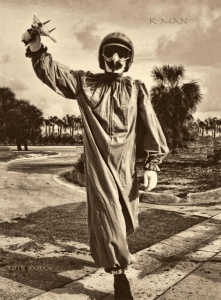
Bartlett was born in Cuba in 1957, but spent eight years of his childhood living in Puerto Rico, during which time he precociously drew picture after picture of the island life around him. His experiences there would become a major thematic influence on his adult work. “He really related to the island and the people,” Ana Bartlett recalls. “He even made sure to keep his Puerto Rican accent when he spoke Spanish.”
By the mid-1970s he had migrated to Miami, where he attended Miami-Dade Community College. Freytes remembers first meeting him there in a painting class. Bartlett, he says, was already thumbing his nose at authority, painting on the same sheet of paper all semester and turning it in to his professor for every assignment. It ended up as a thick, heavy folio with globs of acrylic paint layered on both sides. Freytes recalls another memorable Bartlett moment, when he happened upon the artist dressed as tiger and rummaging through a Dumpster behind an art-supplies store. The two became fast friends and rented a Coconut Grove apartment together.
Sometimes alone and sometimes with other artists, Bartlett as Kendallman would don outrageous outfits and engage in disruptive performance art all around the Grove – on the street, in bars, at art exhibitions. He’d go to punk-rock shows in South Beach and stand in the middle of the mosh pit dressed as a hippy guru. He’d picket Kendall Drive with a sign that read, “Cars Kill.”
In 1984 he invaded an exhibition at the now-defunct Warehouse Gallery Theater wearing his “Mr. Saturn” outfit, which included a huge headpiece shaped like the ringed planet. He couldn’t see from inside the costume, and he had to be led about as he scattered anti-religious screeds throughout the gallery. He was physically removed from the building, which caused a number of participating artists to pull their work from the show in solidarity.
Ejection, even arrest, was not uncommon. “He suffered a lot for it, because a lot of people didn’t understand,” Ana Bartlett says. He was wearing mosquito netting, camouflage vest, and a face paint when she met him at a John Cage lecture at FIU. “At the time, that was an affront to people. It was shocking.” It also appealed to her, and soon she got in on the act. Before long they were performing under the name Missile and Rocket. The two married in 1983, and two kids followed in 1987 and 1995.
Fatherhood did not slow down the artist. In fact he became even more devoted to the idea of life as art. His performances became more focused and thematic, and included the creation of the Art Kendallman/KMAN character. Aircraft and notated flight patterns became an increasingly important part of his work. He’d build model airplanes and carry them all across town on “reconnaissance missions,” keeping detailed “flight logs” of his travels. The line between his performance persona and his “real” life began to blur. He would show up in full regalia on parents’ night at his son’s school; he would even stay in character during family vacations.
A new era began for him earlier this decade, when Miami’s art scene exploded in Wynwood. “He used to be really extreme in these crazy outfits. He must have been stifling in the heat,” says Brook Dorsch, who always welcomed Kendallman’s antics into his Dorsch Gallery, which was not air-conditioned at the time. “It was almost like he would invade the art galleries. He got kicked out of a lot of places, but I didn’t think he was doing anybody any harm. It was just part of the spectacle.”

Gradually Kendallman began to find some acceptance in this burgeoning scene. By 2007 he had his first-ever solo show, at Edge Zones Contemporary Art gallery, where he was allotted 6000 square feet of space in which to work. He also traveled to Puerto Rico to take part in the CIRCA art fair, and to the Dominican Republic for a series of performances. He proudly participated in “Arte No Es Vida: Actions by Artists of the Americas, 1960-2000,” at El Museo del Barrio in New York City, a retrospective of Latin American performance art. And last year he was invited to show in a group exhibition show at the respected Leonard Tachmes Gallery in Wynwood, which led to an impromptu performance in front of Tachmes’s booth at the SCOPE art fair this past December.
Kendallman arrived at SCOPE in typically flamboyant attire. He spread out a tarp on which he’d painted a map of Puerto Rico, then commenced to invade the island with toy warplanes – all while loud music blared from his portable sound-effects equipment. This was done without permission from SCOPE. “He caused quite a scene there,” remembers Tachmes. “It was really funny. I just think that he was a unique person. He always did his own thing and he had a great sense of humor.”
More recently Kendallman/KMAN maintained two Websites, which included with samples of his artwork. Ana Bartlett says the sites became a source of considerable anxiety for her husband, who obsessively checked for hits and comments. With scant online reaction to his work, he felt he was being ignored. “Everything was going right except for cyberspace,” she observes. “I can’t say that’s why he [killed himself], but maybe it’s an indication.”
On June 20, she stepped into her husband’s home studio and found it to be unusually clean and orderly. She says that right away she knew “something was really wrong.” He vanished without a word, leaving his wallet and cell phone at home.
Her fears were confirmed June 28, when he was found dead at the county park in Kendall. He was not in costume. In the past, during darker moments, her husband repeatedly threatened to destroy all his work, and Ana Bartlett suspects he took a portion of his artwork with him and disposed of it.
On July 4, a memorial service was held for him at Matheson Hammock Park. Friends and family gathered to remember the rabble-rousing artist, then his ashes were committed to Biscayne Bay. Says his wife Ana: “He was an artist all the way through. He was at his happiest doing art – that was when he was fully alive.”
For more information visit http://artkman.blogspot.com/ or http://thekendallman.blogspot.com
Feedback: letters@biscaynetimes.com
[/su_tab]
[su_tab title=”Costumed Performe Wants to Unmask Law as Outdated” disabled=”no” anchor=”” url=”” target=”blank” class=””]
COSTUMED PERFORMER WANTS TO UNMASK LAW AS OUTDATED
If art is truth, how come it’s a misdemeanor on the Metrorail?
That’s the question posed by Monkey Joe, an animated, costumed performing artist named Jorge Bartlett who says he has made a career of puncturing the pretensions of Miami‘s art establishment.
Mojo, as Bartlett calls himself, pleaded not guilty Wednesday to charges that the monkey mask he was wearing violated a decades-old law originally designed to keep Ku Klux Klan members from parading with their faces covered. “I was doing a theatrical art performance and was in no way disorderly,” said Bartlett, 29. “I was doing this at the book fair and I extended it to the Metrorail because my clothes were stolen.”
“That might be a good defense,” said Dade County Judge Arthur Maginnes, who seemed to enjoy Bartlett’s case as a change from the usual calendar of routine traffic tickets and petty narcotics charges. “You can bring it up at your trial.”
Maginnes turned down Bartlett’s request for a lawyer, saying there would be no jail time even if he were convicted at his trial in two weeks.
The arrest Nov. 7 came after Mojo refused to stop grunting and hopping around as police tried to question him. Earlier he had been kicked out of the Miami
Book Fair, an annual literary street fair, because he was an “unauthorized artist.”
The frustrated officers described Mojo’s performance in an arrest report as “running throughout the crowd, wildly waving his arms and acting in an animal-like manner.”
The arrest report read: “These officers attempted to question the defendant as he was concealing his identity and harassing train passengers, but the defendant was uncooperative. A search incidental to arrest revealed that the defendant was carrying picture identification on his person that he could have provided to these officers to clear up the question of his concealing his identity, but the defendant had refused.”
Staying in costume means staying in character for Bartlett. “When I’m performing I’m living that person and I don’t see the reason why I should be anything else,” he said.
Besides his monkey outfit, Bartlett has dressed like such made-up characters as “Art Kendallman” and “Mr. Jupiter.” Kendallman is named after Kendall, a Miami suburb.
Bartlett, who also paints and sculpts, has been kicked out of folk art festivals, an advant garde underground music festival, the Miami Magic Festival and other events. He once put adding machine tape and glitter all over trees in Coconut Grove. “Later I realized it was probably stupid, but at the time it was innocent and naive and I was sort of decorating and thought people would think it was funny,” he said.
Dressed for court in bright green pants, a yellow pin-striped jacket and a blue-striped Pepsi Cola truck-driver’s shirt, Bartlett carried a small portfolio that contained a copy of the law he was charged with violating.
The law, which comes under a section dealing with “criminal anarchy, treason, etc.,” bans wearing a “mask, hood or other device” on public property. Subsequent provisions of the law indicate the mask ban was aimed at people who cover their faces “with the intent to deprive any person or class of persons of the rightful protection of the laws.”
Exemptions are made for “theatrical productions,” with Tampa’s Gasparilla festival specifically named as an acceptable place to wear a mask in public.
Tuesday’s court appearance marked the first time Bartlett has been arrested and charged since launching his frequent public performances.
The mask that led to his arrest doesn’t cover his eyes, raising the question of whether it constitutes an illegal face covering. It is a firm surgical mask, painted with a nose and mouth, while his eyes are surrounded by red makeup.
“It gives him more of the mandrill look,” said Michael Jarvis, a friend who has videotaped some of Bartlett’s escapades.
[/su_tab]
[su_tab title=”Jorge Bartlet Living Life as Art” disabled=”no” anchor=”” url=”” target=”blank” class=””]
Jorge Barlett. Living Life as Art
By Anne Tschida

Until he died, Jorge Bartlett lived his art. The performance and visual artist in fact morphed into a persona he called Art Kendallman (a.k.a. KMAN) – he was a man, he lived in Kendall, and he was a piece of art. This is what he had recorded on his Website, under the heading “My Complete Profile”: About Me: Art ; Interests: Art; Favorite Movies: Art; Favorite Music: Art; Favorite Books: Art. No need to second-guess his true passion.
Art Kendallman might best be remembered as the eccentric character who showed up to galleries in outrageous outfits and confronted the art world, maybe wearing something akin to a space suit, with wild helmet and blinking appendages and model planes attached to his body or bike. He was both a spectacle and someone who took this spectacle very seriously. His get-ups appeared vaguely militaristic and he could seem aggressive in his outlandish arrivals, yet there was always something comic to the performance, something that made you smile.
Sadly, Bartlett / Kendallman stopped smiling sometime before June 28th, and ended his life in a park – in Kendall. But for those who knew him, or just bumped into him over the past two decades, his eclectic presence remains.
“His work and performance (could be) a commentary on war,” says sound installation artist Gustavo Matamoros, who remembers Kendallman from encounters on the street and in more private settings. “But he was a man of peace. And he was bold. He didn’t do things in a shy way, he didn’t care what people thought (of his bold persona)… He lived his art, and he embraced his calling. We need more artists like KMAN.”
He didn’t just act out art, he also crafted pieces – work that reflected his quirky yet serious soul. Like his Kendallman Art Gallery, which was inaugurated in Wynwood during Art Basel 2006.
It was a suitcase on wheels, and in his words it was “perhaps possibly maybe, the smallest art gallery in the world.” It exhibited – can you guess? – miniature avant-garde art. In a small nutshell, the suitcase show summed up Kendallman’s process: he hauled around his miniature gallery, opening it up to anyone and everyone – part performance, part static, substantial in content and theory, humorous in presentation and concept.
“His performance and installation work were childish, funny, innocent, proud, fantasy, and original,” recalls gallerist Lenny Tachmes. “I liked it because he was unfazed by the crowd, and because it was so easy for him to interact with others – adults and children – during the performance.” Tachmes was intrigued enough to open his gallery to a “retrospective” of sorts of Kendallman’s drawings.
Bartlett, born in Cuba and raised in Puerto Rico before moving to Miami, had been drawing and painting since the 1980s, but few locals were familiar with that work, at least in a traditional setting. The Art Kendallman decked out in latex with camouflage and head-gear crashing a gallery might not have endeared gallery owners to him; or maybe Kendallman had little interest in a white-box environment – in any event, he hadn’t shown much around town.
But sometime in 2007, says Tachmes, “I got the feeling that he wanted to be in a show. We got to talking about his drawings that he had collected over 20 years related to different aspects of the Miami art and club scene. Because I grew up in Miami I immediately related to some of his stories and black-and-white doodle drawings.” Those doodle-drawings were classic Kendallman. There were wild images of apes and dogs in uniform and planes and invasions (as far back as the early 1980s, Kendallman was already obsessed with aircraft and its military might – on one resume, he lists a show described as Art Kendallman Aircraft Bombing Art Maneuvers. 1984, 1985, 1986, 1987. Performance Air-Art action of hand-held model aircraft at Coconut Grove Art Fest, Coconut Grove). The manic images were scribbled over with numerous phrases such as “Miamimia, Monkey Ass Fault Jungle,” “Aero-surf USA-Japan Chicken Island Cargo Corp.” and other fairly indecipherable commentary.
In fact, they were not that hard to de-code on closer inspection, and with more familiarity with the artist behind the pen. The madness depicted in those etched worlds reflected Kendallman’s view of our own crazed and crazy one. The drawings exuded a cartoonish quality as well as an ever-present darkness. Are we constantly on the verge of invading, or constantly under assault from real and imagined enemies? Is there no escape?
Kendallman had had run-ins with the law – his guerilla art apparently didn’t go over well with cops – and that harassment weighed on him, according to William Keddell, an artist who shows at Brook Dorsch’s gallery, where Kendallman was often a welcomed invader. Like many a creative soul, those dark moments never strayed far from his thoughts.
{mospagebreak}
In his drawings, the funny and fantastical elements collided always with the menacing ones, as they must have in Kendallman himself. “He was professional in his work ethic, reliable and excited to be part of the exhibition,” remembers Tachmes about his show. “But I got the feeling that he was also yearning for recognition and attention to his work; I think he was … frustrated.” Frustration entered into his feelings for one of his last projects, says Matamoros, who recalls that Bartlett / Kendallman never really knew how to sell himself to the hyper-political and clique-ish art world.
That project was Web-based, and loosely involved a cyber invasion of Puerto Rico, his much-loved former home. It of course involved planes, and flight plans for Kendall-Tamiami and San Juan’s airports, and it was supposed to be interactive. But apparently not many visited his site. The heartfelt artist may have felt the world had just become too heartless – but no one ever knows what makes people check out of this life. All we know is what is left behind, and that was an art worth seeing.
One of his most recent interventions occurred at a big satellite fair during Art Basel, Scope. Tachmes had a booth there, and he remembers Kendallman’s spectacular crash of the party, when he set up his own “booth” that was an installation of another version of an invasion of Puerto Rico. “It was really fun and spontaneous. Adults and children alike would stop at the booth and just watch and listen to the music. Kids would get down on the floor next to him and play with the tiny airplanes, ships and soldiers that he had created, laid out over a map of Puerto Rico. It was nice.”
Nice, too, that Miami got to experience the art life of the man from Kendall. Jorge Bartlett, 1957 – 2008.
[/su_tab]
[/su_tabs]

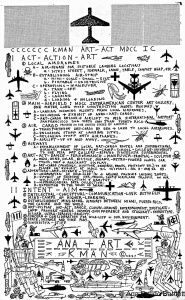

The Kendallman Art Gallery Ambulante
Diorama display of the art action “The Invasion of Puerto Rico as Performance Art” performed at Wynwood in front of Spinello Gallery on 4-12-08 Second Saturday.
Jet aircraft car hood ornament model flight from leonard Tachmes Gallery in Wynwood to Miami Beach.
The Invasion of Puerto Rico as Performance Art.
Orion flight to Rocket Projects in Wynwood after flying at Art Miami 2004.
ARTKMAN
KMAN invades and breaks out in Downtown Miami to recapture the local art world by the KMAN tribe native American life ways. This KMAN performance was intended as a show of force and simply to have a open presence at the Miami Waves Art Festival at MDCC in 1986.One most conquer one’s self and one’s local place before taking over the world.
last of the Mojo trilogy at MDCC Downtown Miami 1986. Mojo was arrested by Miami Metro Dade Police and has never been seen again.
Second of trilogy of Mojo rides on Metro Mover for Miami Waves Art Festival 1986 at Miami-Dade Community College Down Town.
Monkey Joe goes to 111 Flagler St. Federal Government building in Dwn Twn Miami to get written permit from Metro Rail Chief, Transit Marketing on November 26,1986.
Art FoodSpotGroup in Coconut Grov

GALLERY works by KMAN
[supsystic-gallery id=10 position=center]

MSA-X VSPACE thanks to:
credits
artist Jorge Bartlett © ( KMAN )
Gavin Bartlett videos and photos
Ana Bartlett videos and images
Gier Bartlett
Petet Kastan images
Mike Jarvis video
Alejo Menendez video images
Articles
Janet Batet
MARY STAPP
Anne Tschida
Robert A. Liff
Ivette Romero
3d models, Submarine 3D, by Kaisen3D , and
by mabel_design,
other 3d models, by Teo
Music, Teo
exibition design Teo
consulting, Yrsa Davila, Luis Campos, and Javier Martinez
We thank Kman for his brief time on this Planet.

